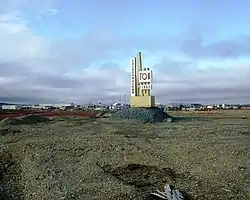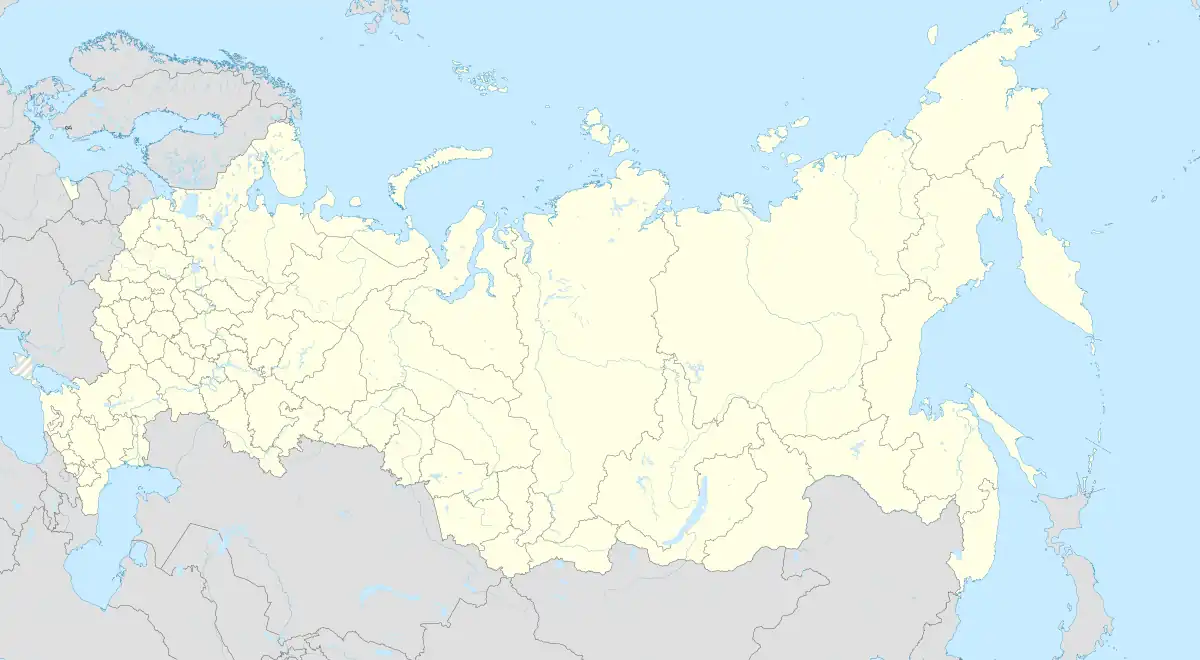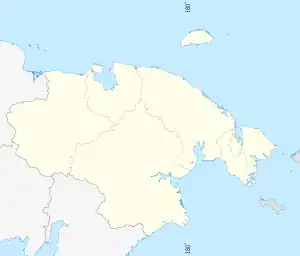Polyarny
Полярный | |
|---|---|
 Monument at the entrance to the abandoned settlement of Polyarny | |
Location of Polyarny | |
 Polyarny Location of Polyarny  Polyarny Polyarny (Chukotka Autonomous Okrug) | |
| Coordinates: 69°09′50″N 178°43′04″E / 69.16389°N 178.71778°E | |
| Country | Russia |
| Federal subject | Chukotka Autonomous Okrug[1] |
| Administrative district | Iultinsky District[1] |
| Founded | 1963 |
| Abolished | 24 May 1995[2] |
| Elevation | 60 m (200 ft) |
| • Municipal district | Iultinsky District |
| Postal code(s)[3] | 686860 |
| Dialing code(s) | +7 42722 |
Polyarny (Russian: Полярный) was an urban locality (an urban-type settlement) in Shmidtovsky District (now merged into Iultinsky District of Chukotka Autonomous Okrug), Russia, about 90 kilometers (56 mi) west of Mys Shmidta.[1] Population: 0 (2002 Census);[4] 4,678 (1989 Census).[5]
History
The settlement was specifically established to house miners working in the nearby goldmines.[2]
In 1961, geologists working in the Pilkhinkuul river valley found a large gold deposit. On March 26, 1963, decree number 104 of the Northeastern Economic Council announced an official decision on the creation of a mine to be named "Polyarny" and a camp of the same name. The first convoy of 15 tractors brought equipment, building materials and everything needed to create the mine and the village. Despite the difficult conditions construction was rapid. The settlement was constructed in three locations: in the centre two-storeyed well-appointed homes and general social infrastructure were built. On the southern outskirts of the settlement, a more private sector was constructed, which became commonly known as "Shanghai" (Russian: Шанхай). This was also the site of a number of wooden houses with few amenities. Finally, in the northern part of the settlement production units were constructed along with a small residential area, which became known as "Bichgrad" (Russian: Бичгра́д), mostly consisting of single-story barracks. Because of its relative remoteness from the main part of the settlement a bus route was organised to the high school in 1975. In the north-eastern part of the village was a base of geologists with the residential area, which was known colloquially as "Exploration" (Russian: Разведка). At the end of the 1980s additional construction of residential buildings began, where people began to move from deplorable housing, where they had been living without repair since the foundation of the settlement. In accordance with the direction of the prevailing wind almost all the houses were oriented from east to west when they were constructed, and because of the permafrost layer, strong foundations were laid and no construction was undertaken higher than two storeys.
When mining became unprofitable, a law was passed in May 1995, abolishing the settlement; it was abolished in 1995.[6] Polyarny had a population of around four thousand during the 1980s, but, as can be seen from the table below, once the mines were closed and the village liquidated, it became a ghost town.
| 1979 | 1989 | 2002 |
|---|---|---|
| 4023[7] | 4678[8] | 0[9] |
In the early 1990s, the level of gold deposits in the Polyarny mines dwindled and more modern methods of extraction were required in order for the area to remain profitable.[10]
Transport
Air
From 1969 air transport was provided on a regular basis, using a dirt runway 450 m in length, located half a mile from the village. Passenger and mail transport was available to destinations across the district and to Pevek. Weather conditions often disrupted flights for several days or even weeks. In 1991, several years before the settlement was formally liquidated, air transport ceased.
Road
Polyarny was only ever connected by road to the neighbouring settlement of Leningradsky, also a settlement established specifically for mining. There was however, a small network of roads within the area, including:[11]
- улица Заречная (ulitsa Zarechnaya)
- улица Набережная (ulitsa Naberezhnaya, lit. Quay Street)
- улица Октябрьская (ulitsa Oktyabrskaya, lit. October Street)
- улица Полевиков (ulitsa Polevikov)
Climate
Polyarny has a Tundra climate (ET)[12] because the warmest month has an average temperature between 0 °C (32 °F) and 10 °C (50 °F).
| Climate data for Polyarny, Chukotka Autonomous Okrug | |||||||||||||
|---|---|---|---|---|---|---|---|---|---|---|---|---|---|
| Month | Jan | Feb | Mar | Apr | May | Jun | Jul | Aug | Sep | Oct | Nov | Dec | Year |
| Record high °C (°F) | −7.8 (18.0) |
−0.7 (30.7) |
1.8 (35.2) |
5.2 (41.4) |
9.7 (49.5) |
25.7 (78.3) |
26.9 (80.4) |
18.9 (66.0) |
16.4 (61.5) |
4.7 (40.5) |
12.3 (54.1) |
−4.1 (24.6) |
26.9 (80.4) |
| Mean daily maximum °C (°F) | −15.4 (4.3) |
−15.9 (3.4) |
−17.4 (0.7) |
−11.8 (10.8) |
−3.3 (26.1) |
4.8 (40.6) |
8.5 (47.3) |
5.8 (42.4) |
0.8 (33.4) |
−6.2 (20.8) |
−11.3 (11.7) |
−14.3 (6.3) |
−6.3 (20.7) |
| Mean daily minimum °C (°F) | −17.6 (0.3) |
−18.2 (−0.8) |
−21.1 (−6.0) |
−16.4 (2.5) |
−6.4 (20.5) |
0.3 (32.5) |
3 (37) |
1.6 (34.9) |
−1.8 (28.8) |
−9.1 (15.6) |
−13 (9) |
−17.1 (1.2) |
−9.6 (14.7) |
| Record low °C (°F) | −39 (−38) |
−40.2 (−40.4) |
−38.9 (−38.0) |
−79.5 (−111.1) |
−22.4 (−8.3) |
−7 (19) |
−13.2 (8.2) |
−5.8 (21.6) |
−16 (3) |
−22.9 (−9.2) |
−33.2 (−27.8) |
−40 (−40) |
−79.5 (−111.1) |
| Average snowy days | 14 | 11 | 7 | 10 | 13 | 5 | 1 | 3 | 11 | 13 | 16 | 17 | 121 |
| Source: [13] | |||||||||||||
Gallery
 Accommodation Barracks
Accommodation Barracks View of Dome Mountain
View of Dome Mountain Kindergarten
Kindergarten "Intelligence" Quarter
"Intelligence" Quarter Gaidara Street
Gaidara Street "Shanghai", the southern outskirts of the settlement
"Shanghai", the southern outskirts of the settlement
References
Notes
- 1 2 3 4 Полярный (пос. гор. типа в Магаданской обл.) from Great Soviet Encyclopedia. Retrieved 21 June 2020 (in Russian)
- 1 2 Polyarny (Chukotka Autonomous Okrug) at deadcities.com (in Russian)
- ↑ Почта России. Информационно-вычислительный центр ОАСУ РПО. (Russian Post). Поиск объектов почтовой связи (Postal Objects Search) (in Russian)
- ↑ Russian Federal State Statistics Service (21 May 2004). Численность населения России, субъектов Российской Федерации в составе федеральных округов, районов, городских поселений, сельских населённых пунктов – районных центров и сельских населённых пунктов с населением 3 тысячи и более человек [Population of Russia, Its Federal Districts, Federal Subjects, Districts, Urban Localities, Rural Localities—Administrative Centers, and Rural Localities with Population of Over 3,000] (XLS). Всероссийская перепись населения 2002 года [All-Russia Population Census of 2002] (in Russian).
- ↑ Всесоюзная перепись населения 1989 г. Численность наличного населения союзных и автономных республик, автономных областей и округов, краёв, областей, районов, городских поселений и сёл-райцентров [All Union Population Census of 1989: Present Population of Union and Autonomous Republics, Autonomous Oblasts and Okrugs, Krais, Oblasts, Districts, Urban Settlements, and Villages Serving as District Administrative Centers]. Всесоюзная перепись населения 1989 года [All-Union Population Census of 1989] (in Russian). Институт демографии Национального исследовательского университета: Высшая школа экономики [Institute of Demography at the National Research University: Higher School of Economics]. 1989 – via Demoscope Weekly.
- ↑ Постановление Правительства РФ от 24 мая 1995 г. N 518 О мерах социальной защиты населения поселка Полярный Шмидтовского района Чукотского автономного округа, связанной с ликвидацией поселка и переходом Полярнинского горно-обогатительного комбината на новую технологию добычи золота. (On measures for the social protection of the population of Polyarny, Shmidtovsky District of Chukotka Autonomous Okrug, associated with the elimination of the village, the Polyarninskogo ore-dressing and processing enterprise and on new technology of extracting gold).
- ↑ Перепись населения СССР 1979 года Archived 2012-03-23 at the Wayback Machine 1979 census of the Soviet Union
- ↑ Всесоюзная перепись населения 1989 г. Численность городского населения РСФСР, ее территориальных единиц, городских поселений и городских районов по полу All-Union census, the constituent entities of the Russian Federation, in the federal districts, towns, rural settlements and regional centres with a population of more than 3,000.
- ↑ Численность населения России, субъектов Российской Федерации в составе федеральных округов, районов, городских поселений, сельских населённых пунктов – районных центров и сельских населённых пунктов с населением 3 тысячи и более человек 2002 Russian Census
- ↑ "Pyotr Mikhailov, In the Depths of the Chukotka Ores // Ogonyok, №52, 2008 г." Archived from the original on 2012-09-10. Retrieved 2013-02-25.
- ↑ Polyarny, Chukotka Autonomous Okrug Pochtovik Mail Delivery Service (in Russian)
- ↑ McKnight and Hess, pp.235–7
- ↑ "Weather Averages for Polyarny, Chukotka Autonomous Okrug from meoweather.com". meoweather.com. Retrieved February 25, 2013.
Sources
- McKnight, Tom L; Hess, Darrel (2000). "Climate Zones and Types". Physical Geography: A Landscape Appreciation. Upper Saddle River, NJ: Prentice Hall. ISBN 0-13-020263-0.
External links
- Adventures in the Polyarny area
- Film about life in Leningradsky and Polyarny:
- Winter photographs of Polyarny (in Russian)